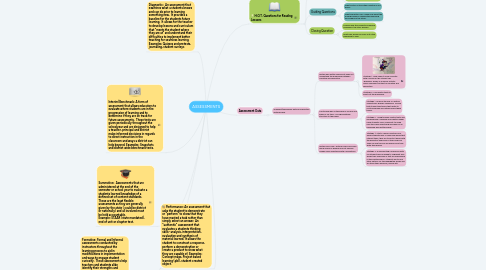
1. Diagnostic: An assessment that examines what a students knows and can do prior to learning something new. It provides a baseline for the students future learning. It allows for the teacher to develop lessons and curriculum that "meets the student where they are at" and understand their difficulties to implement better teaching for seamless learning. Examples: Quizzes and pretests, journaling, student surveys
2. Performance: An assessment that asks the student to demonstrate or "perform" to show that they have masted a task rather than simply select an answer. An "authentic" assessment that evaluates a students thinking skills- analysis, interpretation, evaluation and synthesis of material learned. It allows the student to construct a response, perform a demonstration or create a product to show what they are capable of. Examples: Concept maps, Project based learning (pbl), student created object.
3. Interim/Benchmark: A form of assessment that allows educators to evaluate where students are in the progression of learning and to determine if they are on track for future assessments. These tests are given periodically throughout the schoolyear and are designed to help a teacher, principal and district make informed decisions in regards to direct instruction in the classroom and ways a district can help beyond. Examples: Snapshots and district wide benchmark tests.
4. Summative: Assessments that are administered at the end of the semester or school year to evaluate a students learned knowledge of a defined set of content standards. These are the least flexible assessments as they are generally given by the state ( could be district or nationally) and all involved must be held accountable. Example: STAAR (state mandated), end of unit or chapter test.
5. Formative: Formal and Informal assessments conducted by instructors throughout the learning process to aid in modifications in implementation and ways to engage student curiosity. These assessments help teachers and students alike identify their strengths and weaknesses- highlighting areas that need additional work. Example: Think-Pair-Share, Round Robin, Exit Tickets
6. H.O.T. Questions for Reading Lessons
6.1. Opening Questions
6.1.1. What clues does the title give me about the story?
6.1.2. What predictions can I make about this story based on the title and the cover illustration?
6.2. Guiding Questions
6.2.1. What picture is the author painting in my head?
6.2.2. What prediction can I make now about the ending based on reading the beginning and middle of the story?
6.3. Closing Question
6.3.1. Analyze how the character's feelings changed in the story. Explain.
6.3.2. What plan would you carry out if this happened to you?
7. Assessment Data
7.1. Snapshot/Benchmark Data for Expository Writing Piece.
7.1.1. Writes well written pieces but does not understand the difference between narrative and expository
7.1.1.1. Strategy 1: Help make it more concrete with a visual for the student like "grandma" shown in a journal activity. Teach compare/contrast of narrative and expository.
7.1.1.2. Strategy 2: Use mentor texts to point out the difference.
7.1.2. Controlling idea of the paper is unclear and paper is off topic. No organizational structure to the paper.
7.1.2.1. Strategy 1: Enforce the use of writing "brainstorm" graphic organizers. Ensure that student has topics that relate to controlling idea and details below these topics.
7.1.2.2. Strategy 2: Using teacher mentor texts and showing how I organize and create a paper. Have students use a "checklist" to make sure they have everything included for an organized well written paper.
7.1.3. Writes fairly clear- writing is very formulaic. Word choice is general and not specific. Needs some assistance with conventions.
7.1.3.1. Strategy 1: Start a "word collection box". When students hear or read new words that interest them, they are to write it down with the definition and place in their card box. They can use this box as reference as they write their pieces.
7.1.3.2. Strategy 2: During writing conference with me students will be asked to "highlight five" words they overused or that are replaceable in their writing piece. Students are to find other options for the highlighted words and an utilize their word box, friends etc.
